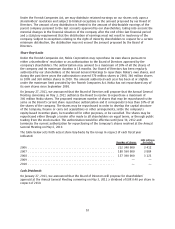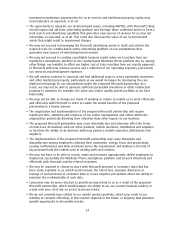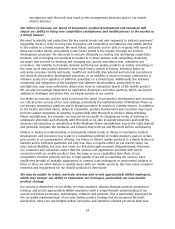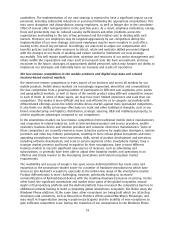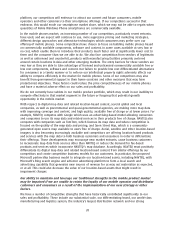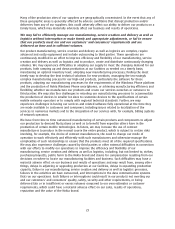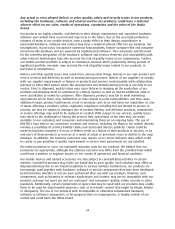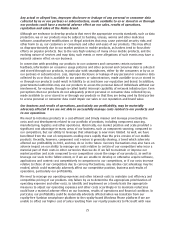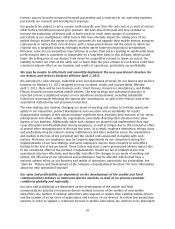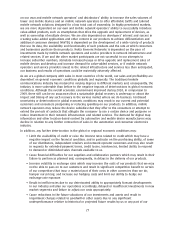Nokia 2010 Annual Report Download - page 21
Download and view the complete annual report
Please find page 21 of the 2010 Nokia annual report below. You can navigate through the pages in the report by either clicking on the pages listed below, or by using the keyword search tool below to find specific information within the annual report.platform, our competitors will endeavor to attract our current and future consumers, mobile
operators and other customers to their smartphone offerings. If our competitors succeed in that
endeavor, this would erode our smartphone market share, which we may not be able to regain when
quantities of Nokia Windows Phone smartphones are commercially available.
In the mobile phones market, an increasing number of our competitors, particularly recent entrants,
have used, and we expect will continue to use, more aggressive pricing and marketing strategies,
different design approaches and alternative technologies which consumers may prefer over our
offering of mobile phones. Some competitors have chosen to focus on building mobile phones based
on commercially available components, software and content, in some cases available at very low or
no cost, which enable them to introduce their products much faster and at significantly lower cost to
them and the consumer than we are able to do. We also face competition from vendors of legitimate,
as well as unlicensed and counterfeit, products with manufacturing facilities primarily centered
around certain locations in Asia and other emerging markets. The entry barriers for these vendors are
very low as they are able to take advantage of licensed and unlicensed commercially available free or
low cost components, software and content. Our failure to provide low cost differentiated alternatives
for consumers in a timely manner or to enforce our intellectual property rights adversely affects our
ability to compete efficiently in the market for mobile phones. Some of our competitors may also
benefit from governmental support in their home countries and other measures that may have
protectionist objectives. These factors could reduce the price competitiveness of our mobile phones
and have a material adverse effect on our sales and profitability.
We do not currently have tablets in our mobile product portfolio, which may result in our inability to
compete effectively in that market segment in the future or forgoing that potential growth
opportunity in the mobile market.
With respect to digital map data and related locationbased content, several global and local
companies, as well as governmental and quasigovernmental agencies, are making more map data
with improving coverage and content, and high quality, available free of charge or at lower prices. For
example, NAVTEQ competes with Google which uses an advertisingbased model allowing consumers
and companies to use its map data and related services in their products free of charge. NAVTEQ also
competes with companies such as TomTom, which licenses its map data and where competition is
focused on the quality of the map data and pricing, and Open Street Map, which is a community
generated open source map available to users free of charge. Aerial, satellite and other locationbased
imagery is also becoming increasingly available and competitors are offering locationbased products
and services with the map data to both business customers and consumers in order to differentiate
their offerings. Those developments may encourage new market entrants, cause business customers
to incorporate map data from sources other than NAVTEQ or reduce the demand for feebased
products and services which incorporate NAVTEQ’s map database. Accordingly, NAVTEQ must positively
differentiate its digital map data and related locationbased content from similar offerings by our
competitors and create competitive business models for our customers. In particular, the proposed
Microsoft partnership business model to integrate our locationbased assets, including NAVTEQ, with
Microsoft’s Bing search engine and adCenter advertising platform to form a local search and
advertising capability that generates new sources of revenue for us may not materialize as expected,
or at all. This could also decrease the value of our locationbased assets that might result in
impairment charges.
Our ability to maintain and leverage our traditional strengths in the mobile product market
may be impaired if we are unable to retain the loyalty of our mobile operator and distributor
customers and consumers as a result of the implementation of our new strategy or other
factors.
We have a number of competitive strengths that have historically contributed significantly to our
sales and profitability. These include our substantial scale, our differentiating brand, our worldclass
manufacturing and logistics system, the industry’s largest distribution network and our strong
20


